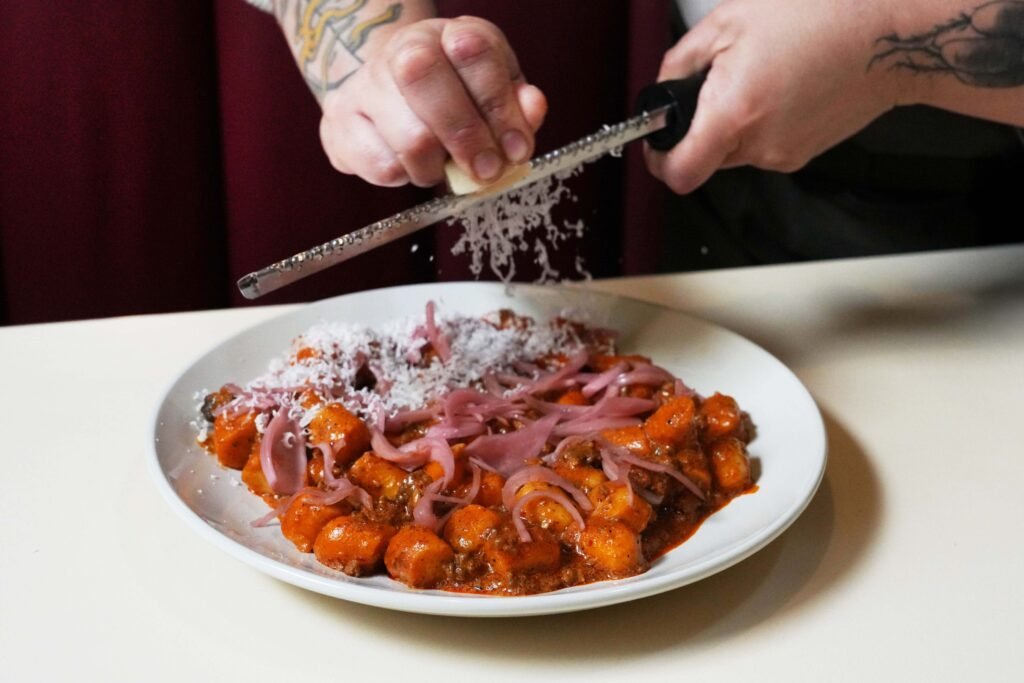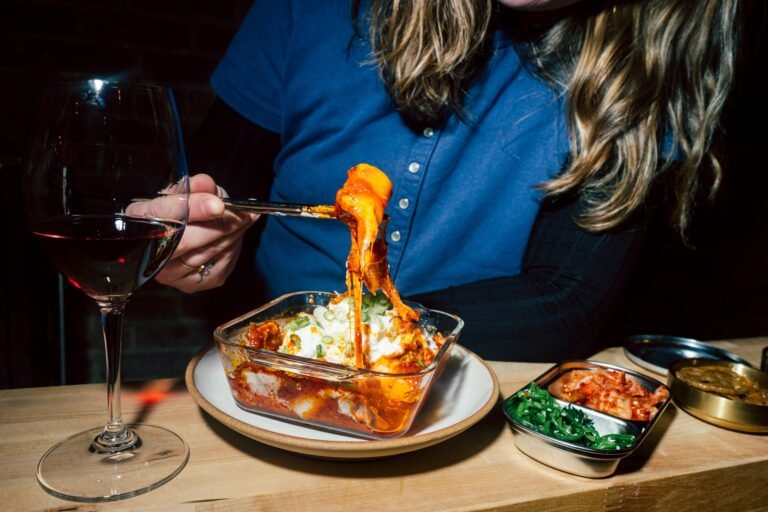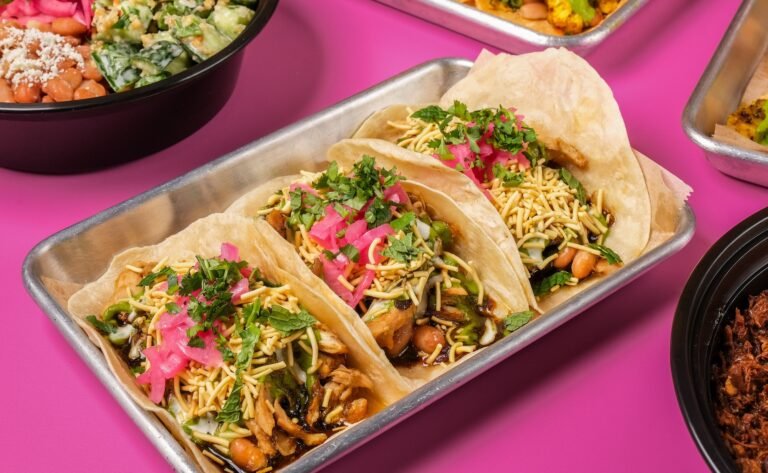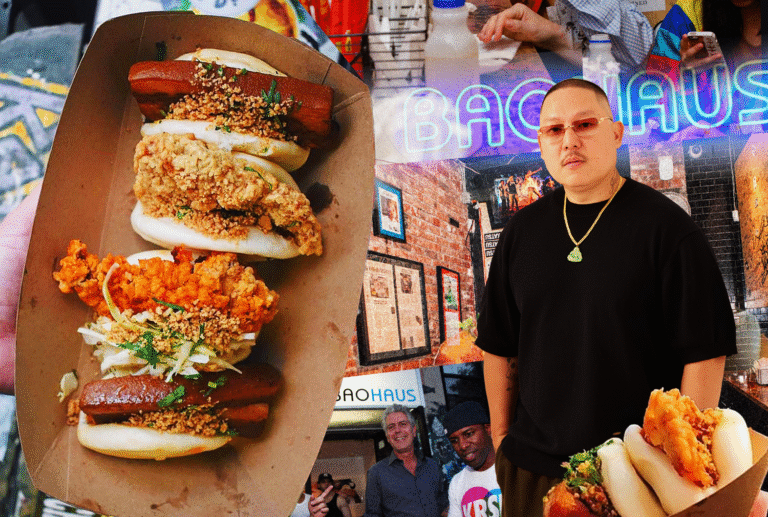

In 2023, the Los Angeles izakaya Budonoki, then just a few weeks old, decided to “dress up” as a different kind of restaurant for Halloween. For one night, the Japanese restaurant transformed into an Italian trattoria with Negroni slushes, arancini, and checkered tablecloths. Someone on staff offered the pun “Budo-gnocchi,” recalls co-owner Eric Bedroussian. “We were like, wait, that’s actually really good.”
Nobody in the kitchen had expertise in making pasta and no one had much interest in making gnocchi from scratch, so the team reached for something more convenient: Korean rice cakes, also known as tteok. Like gnocchi, rice cakes offer a bouncy chew, especially the long cylindrical rice cakes that the restaurant uses. (Tteok can also be found in flatter rounds that are sliced on the diagonal.) The team steamed the rice cakes to soften them, then seared them to create a crisp outer layer. Sauteed mushrooms, a dashi-butter pan sauce, and Parmigiano-Reggiano rounded out the pasta-like vibe.
The Budo-gnocchi was “so incredibly well-received,” Bedroussian says, that it had to become a part of the permanent menu. It hit the notes the restaurant was going for with every other dish. “It’s comforting and it fills you up if you’ve been drinking a lot,” he says. Once a happy accident, Budo-gnocchi has since become a signature dish at the restaurant, which was named an Eater Best New Restaurant in 2024.
The dish has since evolved into a loose template, changing with the whims of the kitchen. The restaurant might upgrade it by finishing with black truffle shavings, or bringing in corn and tomatoes in the summer. “It can be whatever we want it to be,” Bedroussian says.
As Korean cuisine gains popularity across the United States, rice cakes — a popular street food — have established themselves as a promising ingredient for chefs cooking both inside and outside Korean cuisine. While you’ll find them cast as other types of noodles (Sunny Lee’s baked ziti-like rice cakes at New York City’s Sunn’s, for example, or chef Beverly Kim’s tteokbokki pad Thai at Chicago’s Parachute HiFi), chefs especially like the way their playful, chewy texture makes them a natural substitute for gnocchi. This idea isn’t entirely novel; in a 2006 New York Times review of New York’s Momofuku Ssäm Bar, Pete Wells recommended the rice cakes topped with Sichuan pork ragu and whipped tofu as “dead ringers for gnocchi.”
Chefs in Korea have been working on a similar culinary track for a little while now too. Traditionally, restaurants and street stalls generally use tteok to make tteokbokki, in which the rice cakes are simmered in sauce that’s slightly sweet, spicy, and fiery red from gochujang. In recent years, they’ve been riffing with rosé tteokbokki, which adds cream to the typical tteokbokki base, inspired by both the Italian rosé sauce and Korean-style carbonara.
“Italian food in general has become more popular in Korea,” says bar owner and forthcoming cookbook author Irene Yoo. Given that Korean-style carbonara is made with cream and served with ham or peas, breaking from Italian tradition, rosé tteokbokki is “an interpretation of another interpretation,” she says.

Across the U.S., rice cakes have recently transcended pasta dishes altogether. In New York City alone, there’s the culinary boundary-blurring rice cake fundido at Haenyeo; the nacho-like chopped cheese rice cakes at Nowon; rice cakes bulking up galbi bourguignon alongside potatoes at Sinsa; and blanketed with mornay sauce until they resemble gratin at Gurume.
At Yoo’s Orion Bar in Brooklyn, rice cakes also turn sweet, morphing into churros: deep-fried until puffy and crispy on the outside, then tossed in cinnamon sugar and served with cream cheese-makgeolli dip. “I grew up in LA, so I definitely had a lot of churros growing up,” Yoo says. While testing deep-fried rice cakes, “I immediately thought of that as a taste memory.”
For chef Nick Wong of Houston’s new “modern Asian American diner,” Agnes and Sherman, a dish of rice cakes with beef ragu filled the slot for a “comforting, saucy starch” on the menu, since there’s no pasta. It also represents a “kind of ‘if you know, you know’ situation,” he says. Wong spent years cooking at Ssäm Bar, so the dish is in part a reference to the ragu rice cakes there, though with pork in place of beef because “it’s Texas,” Wong says, and to account for Houston’s Muslim population.
More specific to Houston, the dish has another reference: The Korean braised goat and dumplings, also made with rice cakes, was the signature dish at Chris Shepherd’s now-closed Underbelly; the dish was beloved for the way it evoked the foods of many different cultures. With a sauce featuring Korean gochujang and doenjang, West African uda pepper, and Mexican chile de árbol, Wong’s rendition is emblematic of Houston, where, he says, “it’s hard to tell where one thing ends and another thing begins.” When it comes to his rice cake dish, Houstonians “just get it,” he says.
With all its iterations, Budo-gnocchi is a “chameleon” too, Bedroussian says. For a recent collab dinner with Indian sports bar Pijja Palace — an Eater Best New Restaurant that’s known for its malai rigatoni (pasta with a creamy tomato masala) — the two restaurants served malai Budo-gnocchi. It’s a little bit of everything: Italian, Indian, Korean, all through the lens of an LA riff on a Japanese izakaya. Between all those influences, rice cakes are in the middle, bridging the gap.


